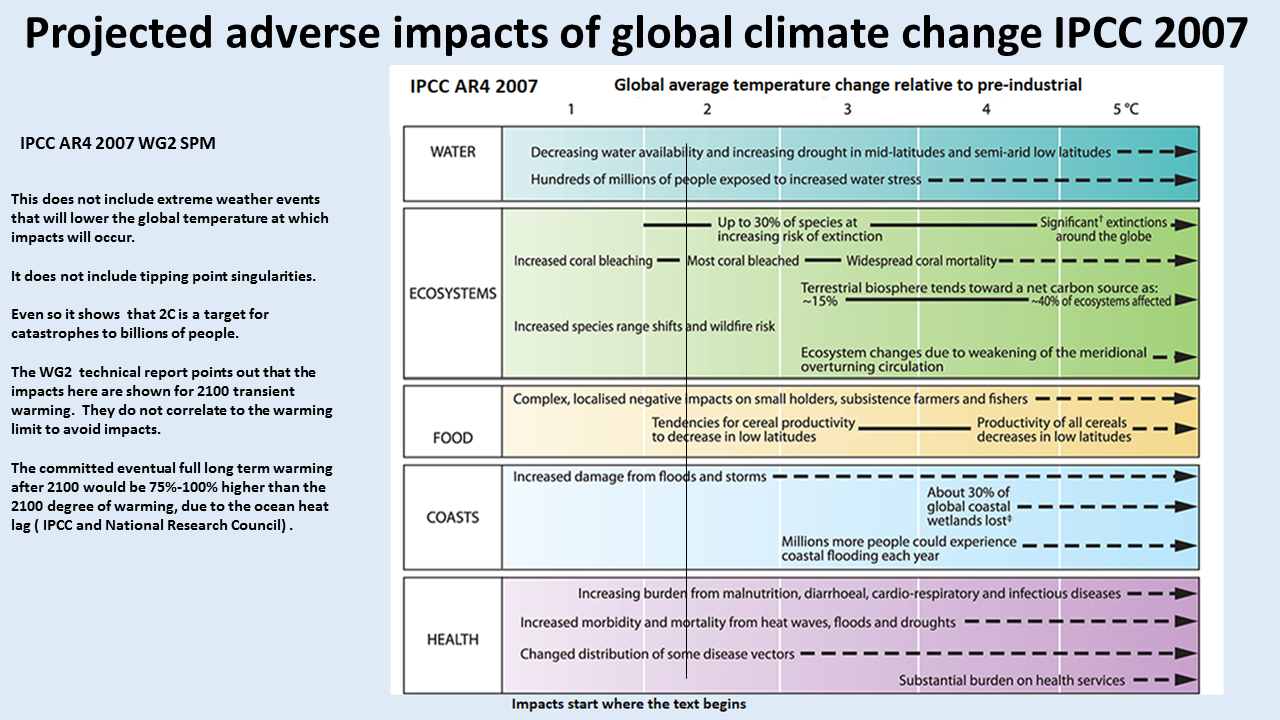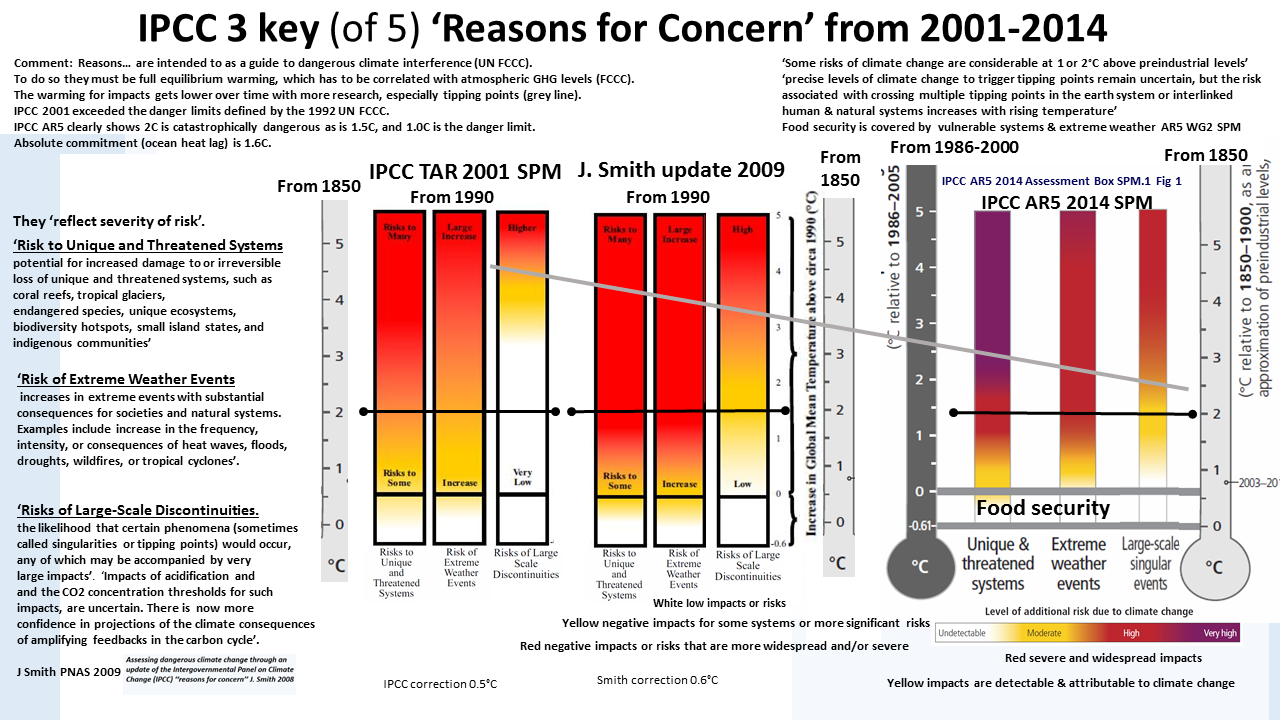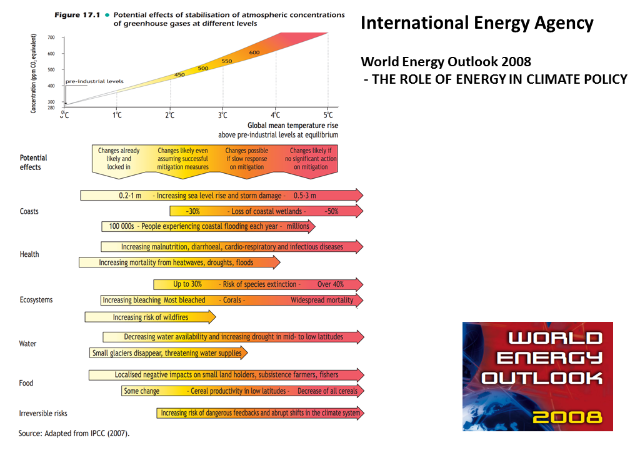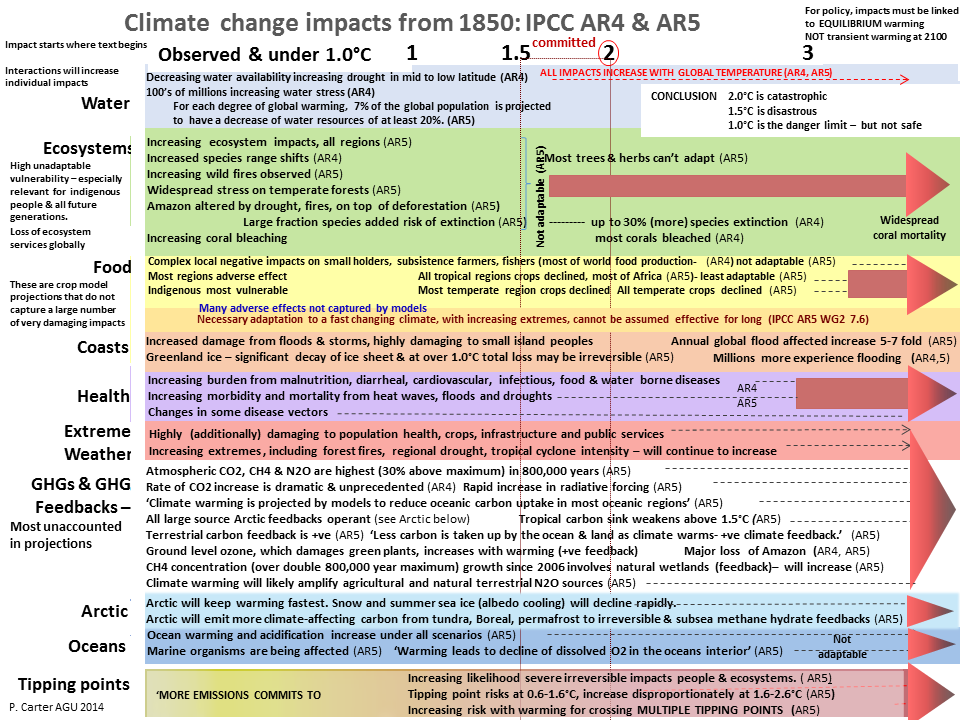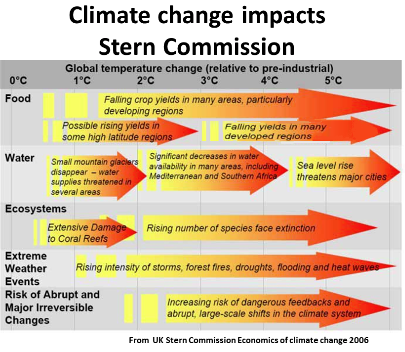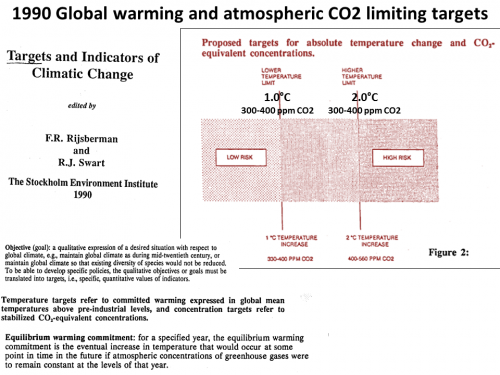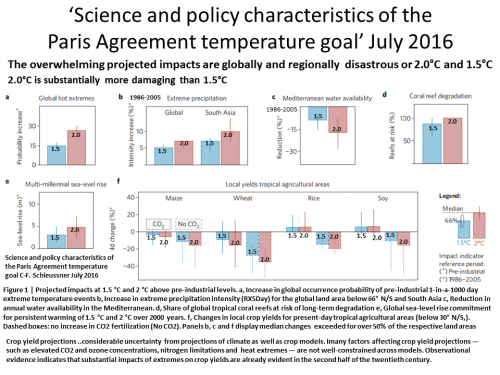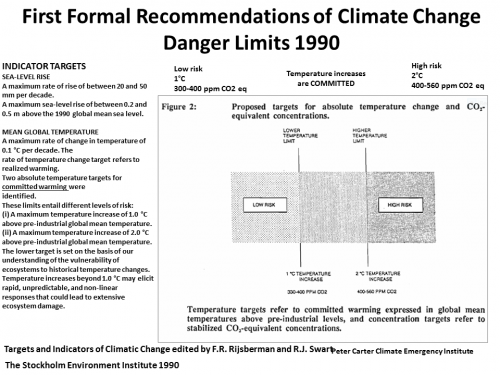NOT 2C anymore ! Only under 1.5C for us all to stay alive
James Hansen July 2011 http://www.giss.nasa.gov/research/briefs/hansen_15/
The 1996 EU 2C policy target was said to avoid the 'worst impacts' of global climate change. These worst impacts refer to huge irreversible planetary changes and so-called runway global climate change caused by multiple Arctic amplifying feedbacks. How ever the EU has always said 2C cannot be considered 'safe' and that it only minimizes the risk of runaway- not exclude the risk.
The danger limit 2C was not originated by climate scientists, but by an economist William Nordhaus who appears to have a greater influence on climate change thinking than the scientists. Nordhaus based on 2C as assumed limit to the past global temperature (100,000 years), that so much GHG had been added to the atmosphere that low temperature increase limits were not feasible, a climate change economic model he developed and his estimates of enormous economic costs of stringent greenhouse pollution reduction. By climate experts at the time 2C was seen as the catastrophe limit.
In 1996 the EU made 2C the policy limit, but the EU has acknowledged 2C is not safe and that it does not exclude the risk of runaway climate change but minimizes it. This is what is meant by the general 2C description of avoiding the 'worst impacts' of climate change.
A 2008 EU science committee reassessed the 2C policy target.
"Global warming of 2ºC above pre-industrial levels cannot be considered safe. Considerable climate change impacts are already felt today and will have to be faced in the future – even below 2°C. Beyond this level, climate change impacts will increase substantially in scale and severity, including threats to unique ecosystems, risks of multi-meter long-term sea level rise, and both more frequent droughts and floods across the globe.
Agriculture and food security
Risks to food production and security are projected to differ greatly by region. Above a global temperature rise of 1.5 to 2°C there is an increasing risk of a decline in global food production. Even below this level, at lower latitudes, especially in the seasonally dry tropics, agriculture will be negatively affected by climate change with negative
impacts on the yield of major cereal crops. Food security and agricultural incomes are likely to be under threat in many regions of Africa, Asia and Latin America.
Health
Human health will be strongly affected by climate change. Severe heat stress has already caused loss of life in Europe (cf. Section 2.2) and other regions of the world. Even a moderate temperature increase well below 2°C is likely to result in negative impacts in the health sector such as increased burden from malnutrition, increased incidence of diarrheal diseases and many vector-, food-, and water-borne infectious diseases. In particular, it will lead to a net increase in the geographic range of malaria and dengue fever.
Extreme events
Increases in global mean temperatures will result in significant changes in the intensity, frequency and location of extreme events such as heat waves, flooding, wildfire and tropical cyclones, even below 2°C rises in temperature.
Coastal zones, small islands, sea-level rise
Sustained global warming greater than 1.5-2.5°C is a threshold beyond which there is likely to be a commitment to at least partial deglaciation of the Greenland ice sheet, and possibly of the West Antarctic ice sheet, causing sea level rise of 4-6 m over centuries to millennia.
Distribution of impacts
The impacts of climate change are not evenly distributed across regions and sectors. At global warming levels below 2°C, a few sectors in certain regions might benefit from climate change (e.g., agriculture and tourism in high latitude regions), while in most other regions and sectors effects are likely to be negative, and sometimes even severely so.
Economic impacts
Many economic sectors and activities will be adversely affected by climate change (Stern, 2006). Current studies estimate that, for a global mean temperature of up to 2 to 3°C above pre-industrial levels, positive market impacts (such as increasing crop yields in higher latitude regions) almost balance the negative market impacts of climate change, giving rise to aggregate impacts of plus or minus a few percent of global gross domestic product. However, positive impacts are not likely to be evenly distributed and most people, particularly in developing countries, would
be negatively affected."
The 2009 Copenhagen Accord has made the EU 1996 2C global warming temperature increase limit international policy. The most climate change vulnerable nations proposed 1.5C and this is supposed to be open for review at some later date by the Accord.
The first temperature increase limit proposed by scientists was by the 1989 UNEP Advisory Group.
• Greater than 1.0°C above pre-industrial levels “may elicit rapid, unpredictable and non-linear responses that could lead to extensive ecosystem damage”.
• 2ºC increase was determined to be “an upper limit beyond which the risks of grave damage to ecosystems, and of non-linear responses, are expected to increase rapidly”.
This was published in 1990 as an international assessment Targets and Indicators published by the Stockholm Environmental Institute, edited by F. Rijsberman and R. Stewart.
"The 2007 Bali conference heard repeated calls .. to avoid exceeding the 2°C threshold. While such endpoint targets dominate the policy agenda, they do not, , have a scientific basis ." (Re framing the climate change challenge in light of post-2000 emission trends K. Anderson and A. Bows Royal Society 2009)
The EU climate science group in 2008 acknowledged in a 2C target assessment that 2C is not safe and cited a great many disastrous impacts and catastrophic risks.
For many years many nations have appealed to the U.N. through the climate change convention negotiating process that they could not survive the 2° C international policy target and it must be lowered to below 1.5°. By 2010 this was over 100 most climate change vulnerable and developing nations (a UN majority). Under the 2010 UN Cancun Climate Conference Agreements it was agreed that the 2° C target would be reviewed by an expert team in terms of lowering it to 1.5 degrees C to be reported by 2015. This position is supported by a the July 2013 expert opinion paper Adequacy and Feasibility of the 1.5C long term goal.
The June 2014 new position statement of the Climate Action Network International
(900 organizations in over 100 countries) included in its position of that warming must be limited to below 1.5° C. The recommendation of that warming must be limited to below 1.5° C was included in a Greenpeace statement 1st of September 2014 and put out in regards to the 23 September 2014 United Nations climate summit.
Though 2C is the only international climate change limit agreed on, the latest research shows it is certain catastrophe for humanity. Indeed the 2007 AR4 IPCC assessment clearly showed 2C catastrophic for billions of people and ecosystems and species.
For many years it has been fairly obvious from the climate change assessments that 1C is the safety limit for global warming and 2C amounts to the worst ever crime against humanity. Even the origin of 2C shows it to be far beyond a planetary safety limit for our future climate.
It is not generally appreciated that 2C refers to the equilibrium warming, which is up to double the realized/transient warming at the time of atmospheric GHG stabilization. To be sure of the global temperature stabilizing at 2C, warming has to be limited to 1C by 2100, so our 2100 limit is 1C how ever we look at it. 2C by 2100 is certain total catastrophe because at it will become 4C over the very long term after 2100- or more if we factor in all amplifying carbon feedbacks resulting from a 4C warming.
In 2009 Jorgen Randers and Paul Gilding proposed “The One Degree War Plan” saying that the public will demand emergency action to cut global climate gas emissions and that such emergency action ought to seek to keep global warming below plus one degree Centigrade over pre-industrial levels.
The Climate Action Network has for years had a position to limit warming far below 2C and the CAN Int. 2014 position is below 1.5C..
WWF has published a series of papers 2C- Too High!
2C has never been described as safe, and there is no science basis of 2C as a danger limit.
The EU 2C policy has always been described as not preventing all dangerous climate change impacts and possibly avoiding only the 'worst' impacts of global climate change.
One of these worst impacts is the planetary catastrophe runaway global climate change, but even for this the EU has said 2C does not exclude the risk of runaway but only minimises it.
Climate change assessments make it obvious 2C is far beyond dangerous by any definition and 1C is the damger limit.
However, without an all out global emergency response, including drastic measures to cool the Arctic and draw down CO2 from the air, it is practically impossible now to avoid going much higher than 2C. This reality is being denied as 'unthinkable'.
"The latest carbon dioxide emissions continue to track the high end of emission scenarios, making it even less likely global warming will stay below 2 °C. A shift to a 2 °C pathway requires immediate significant and sustained global mitigation, with a probable reliance on net negative emissions in the longer term." (Nature Commentary December 2012)
12 Oct 2015 Catalogue of abrupt shifts - in IPCC AR5 Eighteen out of 37 events occur for global warming levels of less than 2°
'There is no such thing as ‘safe’ climate change.
Even the global temperature increase to date (about 0.75°C) is contributing to effects
that are impossible to adapt to in some regions As the temperature rises further, so
will the risk of more widespread and dangerous climate impacts; from sea level rise, increasing frequency and intensity of climate extremes such as heat waves, floods and droughts,' (Royal Society December 2009 'Preventing dangerous climate change The need for a global agreement').
Carbon Brief provides a good short account of Two degrees:
The history of climate change’s ‘speed limit’
1 May 2015 Climate Vulnerability Forum 20 States and 3
independent reports highlight implications of 2 °C versus more ambitious objectives for human rights, the workplace, and migration and displacement.
UNFCCC SED expert review on 2C/1.5C 2013-2015
of changing the 2C target to 1.5C.
A most important commentary - 1.5°C or 2°C:
a conduit’s view from the science-policy interface at COP20 in Lima, Peru by Petra Tschakert.
Here is an interview article
A 2013 report by Ecofys found 1.5C to be preferable and feasible.
In 2015 a UN expert panel published a report on a 2C or 1.5C limit.
Ecofys briefing note of the expert panel findings (found in favor of 1.5C).
A Nature of March 2015 article Global-warming limit of 2 °C hangs in the balance, however made it look the experts were sticking to the catastrophic 2C target.
The expert panel review under the UNFCCC looking at the 2C or 1.5C policy limit finished its reports by 2015 with a Summary report.
"The oft stated goal to keep global warming less than two degrees C is a recipe for global disaster." James Hansen 2008
James Hansen has been published several times explaining that 1.0C is the danger limit based on the latest science finding the climate system more sensitive to warming and many disastrous impacts happening earlier than projected- already. This was the basis of his 2008 350ppm CO2 limit paper. In 2013 with 17 other experts covering a wide range of disciplines and countries he published the most complete call yet to abandon the 2C and go for 1C (even if it seems impossible) in Assessing Dangerous Climate Change.Here is a good article on the long paper.
Cumulative emissions of ,1000 GtC, sometimes associated with 2C global warming, would spur ‘‘slow’’ feedbacks and eventual warming of 3–4C with disastrous consequences.
It was certain from the IPCC 2007 4th assessment that 2C was far past any danger limit definition and 1.5C was also above the 1992 UNFCCC definition and human rights. The IPCC 2001 TAR also showed 2C to be far past the danger limit defined by the 1992 UN FCCC.
With the publication of the 2013-2014 assess fifth assessment of the IPCC, the evidence was overwhelming and obvious that 2° C is intolerably dangerous due to projected multiple disastrous to catastrophic impacts on huge human populations major planetary ecosystems and planetary tipping point. that 1.5° C is dangerous due to the same reasons, and that the true danger limit by the science is 1° C
History of 2C
An analysis of the first appearance of the objective to limit temperature rise to 2°C shows that it has no clear origin and that its adoption is due neither to compelling scientific evidence nor to the negotiators’ informed choice based on scientific date.
The limit emerged out of a marginal remark in an early paper about climate policy .. . The catastrophe view sees it as the threshold separating a domain of safety from a domain of catastrophe (3 views on 2 degrees ECF 2011)
CLIMATE SYSTEM EMERGENCY INSTITUTE
The Health and Human Rights Approach to Climate Change
The 2006 Stern Commission's climate change review published a chart of impacts, which unlike the 2007 IPCC assessment impacts chart, included extreme weather and tipping points. This made it obvious that 2C was far beyond any danger limit definition.
In 2008 the International Energy Agency in its World Energy Outlook published a uniquely useful climate change impacts chart, by including atmospheric CO2 equivalent stabilization levels and an indication of committed future warming and impacts. The chart makes it obvious 2C is catastrophically dangerous, as is 1.5C and 1.0 is the danger limit.
2C Target Not safe.
EU Climate Science Group 2008
In 2009 Bill Hare's chapter in Worldwatch proposed the 1C
danger limit, that James Hansen et al estimated as the danger limit published 2013.
HISTORY The 2C equilibrium global warming started with the EU in 1996.
EU Commission Why 2 degrees target?
'But once global warming exceeds 2°C, climate impacts on food production, water supply and ecosystems are projected to increase significantly and irreversible catastrophic events may occur. Stabilising concentrations at around 450 ppmv CO2 eq in the long term would give a 50/50 chance of staying within the 2°C ceiling. This is the long-term concentration that has guided the Commission in its most recent economic analysis.'
To be able to limit warming to 2.0C emissions must peak-decline by 2015 at the latest IPCC 2007 AR4
1990 Stockholm Environment Institute Targets and Indicators of Climatic Change. F. Rijsberman, R. Stewart
The 1990 expert recommendation was a 1.0C limit on ecosystems which became a definition of dangerous climate interference that must be avoided by nations under the 1992 UN climate change convention.
Note the use of the term committed equilibrium warming. This is not the same as global warming. Committed global warming is much higher than global warming at any particular time, because of climate system inertia.
The committed equilibrium increase is about another 75% (IPCC AR4, AR5) of realized or transient warming as it s now called.
Committed warming is determined by the concentrations of atmospheric GHGs, which was enshrined as the metric in the 1992 UN convention.
Another limit of 2C was cited for what we could call planetary catastrophic runaway climate change.
The 2C committed limit is the long term stabilized 'equilibrium warming of long after 2100. The 2C limit therefore requires warming this century to not exceed 1.2C.
No scientific assessment has clearly justified or defended the 2 °C target as a safe level of warming (Dec 2015 R. Knutti)
Evidence presented under climate impacts makes clear that 2°C global warming would have
consequences that can be described as disastrous (J Hansen et al 2013).
Publications around the 2015 UN Paris Climate Conference refer to a 2C limit as only up to 2100, which would be considerably more than 2C after 2100 to full equlibrium warming (UNEP 2015 Gap, Can Paris pledges avert severe climate change? A. Fawcett Science)
Dr Danny Harvey 2C too High VIDEO
David Spratt Dangerous climate Change Myths & Reality VIDEO
2C would put world food production into decline
2C would devastate the planet due to multiple amplifying feedback runaway (runaway carbon dynamic IPCC).
21 April 2016 1.5 C vs 2 C : New study shows why half a degree matters
"Our results add to a growing body of evidence showing that climate risks occur at lower levels than previously thought. It provides scientific evidence to support the call by vulnerable countries,... that a 1.5°C warming limit would substantially reduce the impacts of climate change," Bill Hare.
Paris Agreement Article 2a '...to pursue efforts to limit the temperature increase to 1.5 °C above
pre-industrial levels, recognizing that this would significantly reduce the risks and impacts
of climate change'
Aug 2017 The 2C tipping tipping point: history
1st 1990 danger limit
recommendation 1.5C
Since the IPCC 1.5C Report and the 2015 UN Paris Agreement, 1.5C has become the danger limit- not 2C
Oct 2015 2C leads to catastrophic abrupt climate change
The evidence (over the last 10 years) is overwhelming that the 2°C limit is global catastrophe
